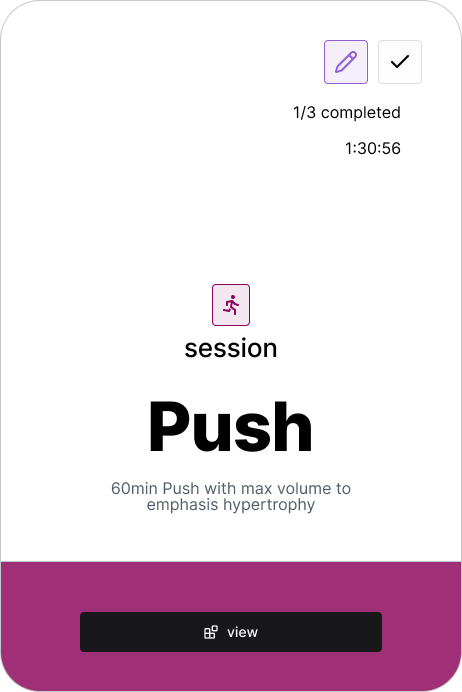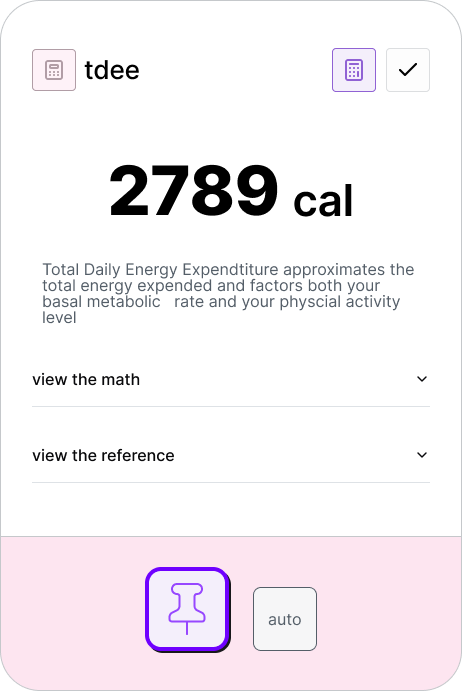a journal which can finally meet your schedule and training ambitions
Current journalling systems are either limited in scope (the majority of sport-specific apps like Strava/Runna), are coach dependent locking you into their services (coaching apps like MyStrengthBook), or don’t have the logic and insights you need (your fallback trusty notebook or excel). Block Bear’s approach allows you to select the things you want to track from an expansive catalogue of measured cards, activity cards, and activity session cards giving you unmatched flexibility to support all your ambitions. Select the cards you care about, build goals and journalling sessions around them, or search the community for science-based presets.Your data. Your goals. Your rhythm. Build, track, and refine every part
of your training with modular cards and adaptive blocks that fit your schedule
— not the other way around.
All cards support trends and goals allowing you to see progression throughout your training. We couple insights with tools like ‘in-flight goal adjustments’ so you never have to abandon your plans. Rather; make the nutritional or training adjustments you need to stay on track.
Lastly we bundle your journalling into distinct training blocks to allow for natural time-based objectives and periodisation. You can start, stop, pause, restart and schedule blocks allowing for your training to finally match your busy schedule.
Connect your journalling into best of the community to find block presets or coached blocks, allowing you to pivot and progress your goals no matter your progression or sport.
journal the things you care about. a simple approach for the entire fitness industry
On the outside the fitness industry is a complex and chaotic place; but its core is the requirement to identify a few things to monitor and a few goals to progress. What these things are, and the direction you want to trend them to is really up to you. Karen might just want to get 6000 steps a day, whereas Bob wants to track his sleep, whilst David Goggins wants to run the 240 miler MOAB whilst maintaining muscle mass. We offer a four step approach for how we should attack this:1
select
select the things which should be monitored.
For example the majority of fitness muscle-building programs track: 1 rep
max bench, 1 rep max deadlift, protein, sleep, daily steps to name a
few.
2
goals
one or two things that you selected will have a goal, else why are we
interested in journalling?
For example: Steps - maintain 5K minimum, bodyweight - increase by 0.5%
per week, 1 rep bench - hit 100kg HOORAH 2 plate club!
3
start and monitor
monitor the trends to see if you’re on track. Adjust other markers as
required, don’t freak out about outliers, check up on some calculations to
see if you’re doing it right.
For example: if you set your weekly run distance too high to the point of
endless shin-splints, adjust this down or decrease other activities to
decrease total time on toes.
4
review and progress
finish the goal, and plan your next training period. For your next block you
may want to keep the trendlines going up, fall back to maintenance if your
next few weeks are busy at work, or do a tactical deload. Review what worked
and what didn’t, search the marketplace for goal and block presets, or even
blocks made by the community, to find what may work next time.
Cards
Measured Cards
Measured cards are things that are measured. Bodyweight, daily step count, max-speed on a wave, total elevation or all examples of measured-cardsfeatures
smart or manual target values
recorded or manual input
notes
pin to pinboard
autocomplete for recorded cards
complete or quick complete for manual cards

Activity Cards
Activity cards are for activities. Bench press, run, surf, intervals, lateral raise, toe touches are all examples of activities
features
smart or manual target values
recorded or manual input
notes
pin to pinboard
autocomplete for recorded cards
complete or quick complete for manual cards
Activity Session Cards
Activity Sessions are collections of activities. For example an interval session is multiple intervals, and a chest workout is multiple sets of fly’s, bench, incline.features
groups of activity cards
total session time
notes

Calculation Cards
Calculations are those calculated insights you need. Total Daily Protein and Energy, Theoretical VO2Max, BMI are all examples of calculation cards.
features
calculated values off your real-time block data
review the calculation
review the reference
Card Features
-
Pin to pinboard. view trends, create goals or add cards throughout the journal through the smart-populate feature.
For example: if you set an incremental increase for your week run distance then the value will be calculated in the target field each week. A common use-case for manual targets is to manual values for fields like rpe and rep count.
-
Smart or Manual Target Values. Smart targets are the value of goal trendline for that session. These are only available if goal is set on it in the pinboard. Alternatively a target can be set in manually.
For example: steps and sleep data are wearable compatible by default. Check these cards throughout the day to see your progress
- Recorded or Manual Inputs. If you connect the measured or activity cards are compatible with your connected wearables then you can set the input to record in the card preferences. This will mean that the value will be synchronised from your devices and tracked automatically.
- Auto Complete. Auto-completing a session will complete the card with all actual values set to the target values. This is for those sessions where you smash it and hit all your targets; hence a one-tap auto-complete will finish the card.